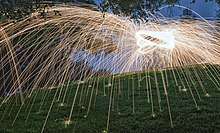Steel wool



Steel wool, also known as wire wool or wire sponge, is a bundle of very fine and flexible sharp-edged steel filaments. It was described as a new product in 1896.[1] It is used as an abrasive in finishing and repair work for polishing wood or metal objects, cleaning household cookware, cleaning windows, and sanding surfaces.[2]
Steel wool is made from low-carbon steel in a process similar to broaching, where a heavy steel wire is pulled through a toothed die that removes thin, sharp, wire shavings.[2]
Uses

Steel wool is commonly used by woodworkers and craftsmen working with paint, lacquer and varnish.[3] However, when used on oak, remaining traces of iron may react with tannins in the wood to produce blue or black iron stain. Bronze wool or stainless steel wool do not cause this.
Steel wool is often used for professional cleaning processes on glass and porcelain because it is softer than those materials and is able to scrape off deposits without scratching the underlying surface like common abrasives. In many countries, soap-impregnated steel wool pads were sold under various trade names[4] for household cleaning, although those products sometimes no longer contain steel wool.
Another use for steel wool is in rodent control. Small holes are plugged with coarse grade steel wool, which, if gnawed on by rodents, causes extreme pain in the mouth and, if ingested, severe internal damage may lead to death.
When steel wool is heated or allowed to rust it increases in mass due to the combination of oxygen with iron.
The fine cross-section of steel wool makes it combustible in air. Light painting, where many sparks are released, is one application. Very fine steel wool can also be used as tinder in emergency situations, as it burns even when wet and can be ignited by fire, a spark, or by connecting a battery to produce joule heating.
Grades
In 2014, steel wool products are supplied in grades from the coarser grades 3 and 4 to the super fine grade 0000. Rust-resistant (stainless) steel wool is also available.
| Grade Name | Grade Code | inches | mm |
|---|---|---|---|
| Super Fine | 0000# | 0.001 | 0.025 |
| Extra Fine | 000# | 0.0015 | 0.035 |
| Very Fine | 00# | 0.0018 | 0.040 |
| Fine | 0# | 0.002 | 0.050 |
| Medium | 1# | 0.0025 | 0.060 |
| Medium Coarse | 2# | 0.003 | 0.075 |
| Coarse | 3# | 0.0035 | 0.090 |
| Extra Coarse | 4# | 0.004 | 0.100 |
See also
References
- ↑ Iron Age, Vol. LVII, p.871, cited by Journal of the Iron and Steel Institute,Volume 50, Issue 2, p.482
- 1 2 Jessica Elzea Kogel; Nikhil C. Trivedi; James M. Barker; Stanley T. Krukowski (2006). Industrial Minerals & Rocks (7th ed.). SME. p. 156. ISBN 9780873352338. Retrieved 2009-07-21.
- ↑ "Steel wool: low-cost, do-everything home and shop material". Popular Science. Vol. 208 no. 5. Bonnier Corporation. May 1976. p. 124. ISSN 0161-7370. Retrieved 2009-07-21.
- ↑ Trade names for soap-impregnated steel wool pads include Brillo Pad, Chore Boy, S.O.S Soap Pad
- ↑ "Steel Wool Grades". The Engineering ToolBox. Retrieved 23 March 2014.